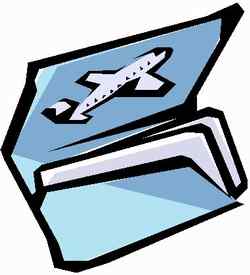Mon, Dec 10, 2007
Electronic Boarding Pass A Sign Of The Times
 Passengers no longer have to dig for
the paper ticket, or worry about where they put their boarding
passes before checking in for a flight. Continental Airlines and
the Transportation Security Administration launched a program to
test using electronic boarding passes on PDAs or cell phones. The
first of it kind boarding pass offered by a US airline is called
the 'Paperless Boarding Pass' pilot program and was kicked off in
Houston, Texas.
Passengers no longer have to dig for
the paper ticket, or worry about where they put their boarding
passes before checking in for a flight. Continental Airlines and
the Transportation Security Administration launched a program to
test using electronic boarding passes on PDAs or cell phones. The
first of it kind boarding pass offered by a US airline is called
the 'Paperless Boarding Pass' pilot program and was kicked off in
Houston, Texas.
The program works like this -- passengers receive boarding
passes on their cell phone or PDA, and are then scanned by TSA
security officers-the paperless boarding passes contain a
two-dimensional bar code that identifies the passenger with their
flight information. The benefit of the electronic boarding pass is,
first, it eliminates the need for a paper boarding pass. Second,
the technology will cut down on passenger fraud. Third, it will
improve customer service and speed up the boarding process.
"The deployment of the paperless technology signifies the TSA's
ongoing commitment to develop and execute new technologies within
aviation while enhancing security," said Mel Carraway, TSA's
general manager for field operations, in a statement. The airlines
and TSA worked together to develop the strategy to use the
paperless process.
 TSA created the paperless scan
process; Continental Airlines came up with a plan for encrypting
the boarding passes on mobile devices. It's not certain that the
program will be used elsewhere, but TSA has expressed interest in
expanding the use of encrypted bar codes.
TSA created the paperless scan
process; Continental Airlines came up with a plan for encrypting
the boarding passes on mobile devices. It's not certain that the
program will be used elsewhere, but TSA has expressed interest in
expanding the use of encrypted bar codes.
In October, the International Air Transport Association
introduced a global standard in October that lays the ground work
for a check-in procedure using cell phones, smartphones, or PDAs
and two-dimensional bar codes. The standard for a two-dimensional
paper bar coded pass was developed in 2005, and is currently used
for Web check-in.
By 2010 all airlines must use bar coded boarding passes,
removing the need for the magnetic strip technology saving he
airlines $500 million a year. Using bar-code--or mobile
electronic--the goal is to get the airlines globally to use one or
the other.
More News
He Attempted To Restart The Engine Three Times. On The Third Restart Attempt, He Noticed That Flames Were Coming Out From The Right Wing Near The Fuel Cap Analysis: The pilot repor>[...]
Make Sure You NEVER Miss A New Story From Aero-News Network Do you ever feel like you never see posts from a certain person or page on Facebook or Instagram? Here’s how you c>[...]
From 2009 (YouTube Edition): Leading Air Show Performers Give Their Best Advice for Newcomers On December 6th through December 9th, the Paris Las Vegas Hotel hosted over 1,500 air >[...]
Aero Linx: NASA ASRS ASRS captures confidential reports, analyzes the resulting aviation safety data, and disseminates vital information to the aviation community. The ASRS is an i>[...]
“For our inaugural Pylon Racing Seminar in Roswell, we were thrilled to certify 60 pilots across our six closed-course pylon race classes. Not only did this year’s PRS >[...]
 NTSB Final Report: Rutan Long-EZ
NTSB Final Report: Rutan Long-EZ ANN FAQ: Turn On Post Notifications
ANN FAQ: Turn On Post Notifications Classic Aero-TV: ICAS Perspectives - Advice for New Air Show Performers
Classic Aero-TV: ICAS Perspectives - Advice for New Air Show Performers ANN's Daily Aero-Linx (06.28.25)
ANN's Daily Aero-Linx (06.28.25) Aero-News: Quote of the Day (06.28.25)
Aero-News: Quote of the Day (06.28.25)




